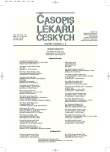Electrocardiography of yesterday and today
Authors:
F. Kölbel
Authors‘ workplace:
Univerzita Karlova v Praze, 2. lékařská fakulta a FN Motol, Interní klinika
Published in:
Čas. Lék. čes. 2009; 148: 358-360
Category:
Review Article
Overview
Electrocardiography is one of most classical methods of examination in medicine and in cardiology. After more than 100 years of practical use, it is indispensable in diagnosing arrhythmias as well as several, clinically important proarrhythmic states. In those, the heart with normal anatomy endangers the patient with the risk of serious, frequently life threatening arrhythmias (Long QT Syndrome, Brugada Syndrome, Wolff-Parkinson-White Syndrome, T-wave alternans). Further, electrocardiography is nowadays important in diagnosing the very fresh signs of myocardial ischemia. Present time electrocardiography is demanding for manufacturers of electrocardiographic machines, and requires precise, standard technique of examination. Despite automatic evaluation programmes of electrocardiogram, which are nowadays almost a standard, physicians should understand well the electrocardiogram, and must be able to correct frequent inaccuracies of the automatic evaluations.
Key words:
electrocardiography, arrhythmias, myocardial ischemia.
Sources
1. Slawnych MP, Nieminen T, Kähönen M, et al. Post- Exercise Assessment of Cardiac Repolarization Alternans in Patiens with Coronary Artery Disease Using the Modified Moving Average Model. J Am Coll Cardiol 2009; 53: 1130–1137.
2. Klingfield P, Gettes LS, Bailey JJ, et al. Recommendations for the Standardization of the Electrocardiogram, Part I: The Electrocardiogram and it’s Technology: a Scientific Statement from the American Heart Association Electrocardiography and Arrhythmias Committee, Council on Clinical Cardiology; the American College of Cardiology Foundation; and the Heart Rhythm Society. J Am Coll Cardiol 2007; 49: 1109–1127.
3. Mason JW, Hancock EW, Gettis LS. Recommendation for the Standardization and Interpretation of the Electrocardiogram, Part II: Electrocardiography Diagnostic Statement List A. Scientific Statement From the American Heart Association Electrocardiography and Arrhythmias Committe, Council on Clinical Cardiology; the American College of Cardiology Foundation; and the Heart Rhythm Society Endorsed by the International Society for Computerized Electrocardiology. J Am Coll Cardiol 2007; 49: 1128–1136.
4. Surawicz B, Childers R,Deal BJ, et al. AHA/ACCF/HRS Recommendations for the Standardization and Interpretation of the Electrocardiogram, Part III: Intraventricular Conduction Disturbances. A Scientific Statement from the American Heart Association Electrocardiography and Arrhythmias Committee, Council on Clinical Cardiology; the American College of Cardiology Foundation; and the Heart Rhythm Society. J Am Coll Cardiol 2009; 53: 976–981.
5. Rautaharju PM, SurawyczB, Gettes LS. AHA/ACCF/HRS Recommendations for the Standardization and Interpretation of the Electrocardiogram Part IV: The ST Segment, T and U Waves, and the QT Interval. A Scientific Statement From the American Heart Association Electrocardiography and Arrhythmias Committee, Council on Clinical Cardiology; the American College of Cardiology Foundation; and the Heart Rhythm Society. J Am Coll Cardiol 2009; 53: 982–991.
6. Hancock EW, Deal BJ, Mirvis DM, et al. AHA/ACCF/HRS Recommendations for the Standardization and Interpretation of the Electrocardiogram, Part V: Electrocardiogram Changes Associated With Cardiac Chamber Hypertrophy. A Scientific Statement A Scientific Statement From the American Heart Association Electrocardiography and Arrhytmias Committe, Council on Clinical Cardiology; the American College of Cardiology Foundation; and the Heart Rhythm Society. J Am Coll Cardiol 2009; 53: 992–1002.
7. Wagner GS, Macfarlane P, Wellens H, et al. AHA/ACCF/HRS Recommendations for the Standardization and Interpretation of the Electrocardiogram. Part VI: Acute Ischemia/Infarction. A Scientific Statement From the American Heart Association Electrocardiography and Arrhythmias Committee, Council on Clinical Cardiology; the American College of Cardiology Foundation; and the Heart Rhythm Society. J Am Coll Cardiol 2009; 53: 1003–1011.
8. Kölbel F. Klinická elektrokardiografie, 2. vyd. Praha: Státní pedagogické nakladatelství 1973
Labels
Addictology Allergology and clinical immunology Angiology Audiology Clinical biochemistry Dermatology & STDs Paediatric gastroenterology Paediatric surgery Paediatric cardiology Paediatric neurology Paediatric ENT Paediatric psychiatry Paediatric rheumatology Diabetology Pharmacy Vascular surgery Pain management Dental HygienistArticle was published in
Journal of Czech Physicians

Most read in this issue
- Pheochromocytoma: diagnosis and treatment
- Diagnostics and treatment of organic hyperinsulinism – experience in 105 cases
- Hypertensive crisis – the present view
- Electrocardiography of yesterday and today
